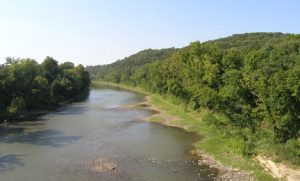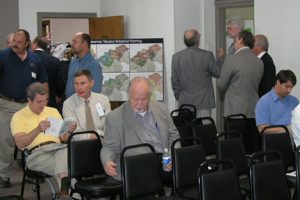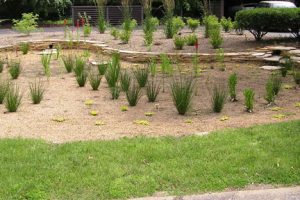 Our water resources are a vital regional asset and therefore stormwater management, floodplain protection, wetland habitat, watershed planning and restoration, wastewater treatment and drinking water are important policy issues which need constant attention.
Our water resources are a vital regional asset and therefore stormwater management, floodplain protection, wetland habitat, watershed planning and restoration, wastewater treatment and drinking water are important policy issues which need constant attention.
East-West Gateway Council of Governments’ (EWG) sustainability planners work to address these issues by facilitating a regional water resources committee, working on regional watershed plans, and providing technical assistant to local governments and sewer districts, among other activities. You can learn more about water resources in the St. Louis region by viewing presentations in the Library.
Current Projects
Learn more about some of EWG’s current water quality efforts:
- BMP Watershed Summit – 2024
- Septic System Information
- Green Infrastructure/Rainscaping
- Lower Meramec Watershed Plan
- Financial Options
Water Resources Committee
 In 2001, EWG organized a regional Water Resources Committee (WRC) for the Missouri Portion of the St. Louis region. The membership of the WRC is composed of representatives from industry, water and sewer districts, communities, government agencies, universities, environmental groups and the general public who work together on actions to improve the region’s water quality.
In 2001, EWG organized a regional Water Resources Committee (WRC) for the Missouri Portion of the St. Louis region. The membership of the WRC is composed of representatives from industry, water and sewer districts, communities, government agencies, universities, environmental groups and the general public who work together on actions to improve the region’s water quality.
Meeting Information
- The WRC meets quarterly
- Meeting Materials and Member List
- Upcoming Meetings
History of Regional Watershed Planning
What is a Watershed?
A watershed is an area of land where the runoff from rain and snow will ultimately drain to a particular stream, river, wetland or other body of water. Watersheds can be as big as the Mississippi River, draining 1.2 million square miles and 33 states, or as small as the land that drains to a creek in your backyard. There are nine major watersheds in the St. Louis region that drain into the Missouri and Mississippi rivers.
As such, a healthy watershed is important to everyone who lives in our region. Watersheds provide plentiful drinking water supplies, habitat for fish and wildlife and water for irrigation, industry or recreational activities. Without clean water supplies our society would be radically changed from what it is today. Standards for a healthy watershed are easily defined by “yes” answers to two important questions. Is the stream or river clean enough for a person to swim in it? Is the stream or river clean enough for fish to thrive?
208 Water Quality Planning
 The 1972 Federal Water Pollution Control Act Amendments laid out a commitment to protect the rivers and streams of the U.S. The major goal was to attain “water quality which provides for the protection and propagation of fish, shellfish and wildlife and provides for recreation in and on the water.” Sections 208 and 201 of this act set forth requirements and procedures to achieve the delineated goals. An approved Section 208 water quality management plan was prerequisite for the 201 planning process to develop and implement community/district wastewater treatment plans.
The 1972 Federal Water Pollution Control Act Amendments laid out a commitment to protect the rivers and streams of the U.S. The major goal was to attain “water quality which provides for the protection and propagation of fish, shellfish and wildlife and provides for recreation in and on the water.” Sections 208 and 201 of this act set forth requirements and procedures to achieve the delineated goals. An approved Section 208 water quality management plan was prerequisite for the 201 planning process to develop and implement community/district wastewater treatment plans.
Under Section 208, Governors from each state designated planning agencies for their metropolitan areas. EWG was designated as one by the governor of Missouri in 1975. Subsequently, a regional water quality plan was developed for Missouri counties of Franklin, Jefferson, St. Charles, and St. Louis and the city of St. Louis. The St. Louis, Missouri Water Quality Management Plan (208 Plan) provided a framework for establishing control strategies to solve both point and non-point pollution problems.
The 208 Plan identified the Lower Meramec River as a high priority stream and major regional asset. The plan detailed the capacity and location of regional and sub-regional wastewater treatment facilities and addressed non-point pollution problems and related issues. The 208 Plan was completed in 1978 and approved by U.S. Environmental Protection Agency in 1979.
- 208 Plan – Part One
- 208 Plan – Part Two
- 208 Plan – Part Three
- 208 Plan – Part Four
- 208 Plan – Glossary of Water Quality Terms and Concepts for Citizens (1976 -1977)
- 2010 Review of the 208 Plan
- All 208 Plan Documents
208 Plan Amendments
There have been 3 Plan amendments:
- Festus/Crystal City Point Source Recommendation (2006) – Jefferson County
- Lower Meramec System (including Rock Creek watershed) Point Source Recommendation (2021) – Jefferson and St. Louis Counties
- Lower Meramec System (including Rock Creek watershed) Residual Waste (Sludge) Management Recommendation (2021) – Jefferson and St. Louis Counties
Click here to view a description of each amendment.
Plan Implementation
EWG has implemented the 208 Plan’s recommendations by: providing technical assistance to local governments and sewer districts; conducting studies on septic tank management, stormwater detention, and low impact development; performing Water Quality Management Plan updates; and facilitating the Regional WRC. Most recently, staff completed the Lower Meramec Watershed Plan from Pacific to Valley Park.

